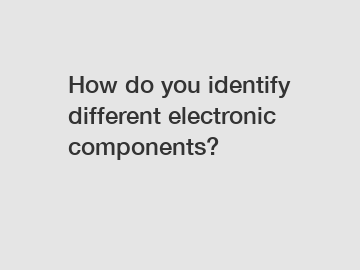How do you identify different electronic components?
In today's advanced technological landscape, electronic devices are an integral part of our daily lives. From smartphones to computers, every gadget we use relies on a complex network of diverse electronic components. But have you ever wondered how these components are identified and what they entail? In this blog post, we will explore the intriguing world of electronic components and provide you with a detailed guide on identifying them.
1. Understanding Resistors:
Resistors are fundamental electronic components that control the flow of current in a circuit. They come in various shapes and sizes, usually with color-coded stripes indicating their resistance value. To decipher these codes, you can refer to online resources or use specialized tools such as a multimeter to measure their resistance.

2. The Mystery of Capacitors:
Capacitors store and release electrical energy. Different types of capacitors include ceramic, electrolytic, tantalum, and polyester capacitors. These components are generally labeled with alphanumeric codes denoting their capacitance and voltage rating. Online databases, datasheets, or component markings can help you unravel the information encoded on them.
3. Making Sense of Diodes:
Diodes are essential for controlling the direction of electrical current flow in a circuit. Identifying diodes can be as simple as recognizing their distinct shape with color bands symbolizing their specific type. Popular diode types include standard silicon diodes, Zener diodes, light-emitting diodes (LEDs), and Schottky diodes.
4. Resolving Transistors:
Transistors are versatile electronic components used in amplifiers, switches, and many other applications. Identifying transistors requires a combination of visual inspection, understanding pin configurations, and reading their markings. With a little practice, you can determine their type (NPN or PNP), gain, and power dissipation capabilities.
5. Decoding Integrated Circuits:
Integrated circuits (ICs) are integral to modern electronics as they contain numerous components on a single chip. ICs can be classified into digital, analog, or mixed-signal types. Identifying the exact functions and specifications of ICs might involve referring to datasheets, markings, or online resources. Moreover, online IC databases like Octopart can provide detailed information about particular ICs.
6. Other Components:
Beyond the basics mentioned above, there are numerous other electronic components such as inductors, transformers, switches, connectors, and sensors. Some of these components may require specialized tools to identify, while others may have specific symbols or markings guiding their recognition.
7. The Role of Creativity:
Identifying electronic components often demands a degree of creativity. By observing patterns, comparing similarities, and researching potential matches, you can refine your skillset and become better at recognizing components. Joining online forums or engaging with electronic hobbyist communities can also broaden your understanding and expose you to innovative techniques for identification.
8. The Burstiness of Electronic Components:
The electronic industry advances rapidly, introducing new components and phasing out older ones. Staying up-to-date with the latest trends and technological advancements is essential for accurate component identification. Regularly reading industry journals, visiting electronics exhibitions, and following reputable websites enables you to stay in sync with the evolving landscape.
9. Embracing Human-like Abilities:
While machines can be invaluable for part identification, there are certain attributes of human-like perception that still excel in this field. Contextual knowledge, intuition, and experience play crucial roles in accurately identifying electronic components. Combining the technical prowess of machines with the expertise of human intelligence facilitates enhanced identification abilities.
Conclusion:
Becoming proficient in identifying different electronic components is a skill that can empower both professionals and enthusiasts alike. By understanding the unique characteristics and specifications of various components, you can repair, upgrade, or even build electronic devices from scratch. Remember to stay curious, explore new resources, and continuously enhance your knowledge to master the art of identifying electronic components.
Want more information on product turning conveyor, Power 90 Degree Turn Belt Conveyor Private Label, China Factory Wholesale Assembly Line Automation Equipment Design? Feel free to contact us.
146
0
0

Comments
All Comments (0)